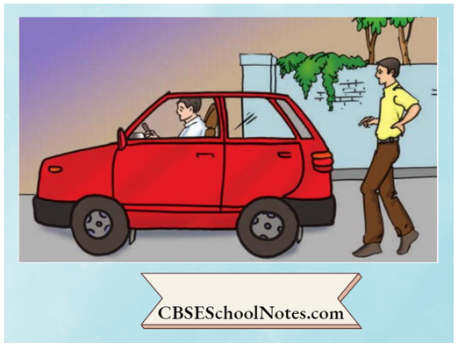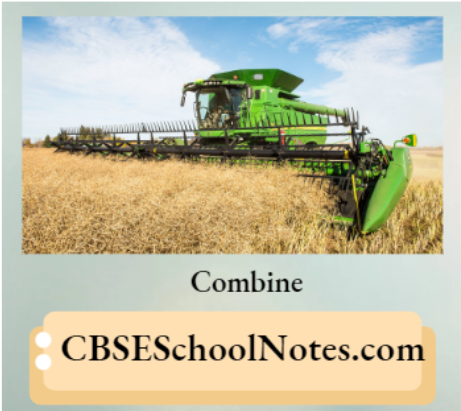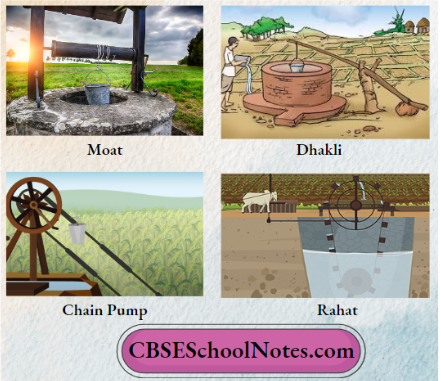Easy-To-Understand Notes On Adolescence Chapter Class 8 Reaching the Age Of Adolescence, Adolescence, And Puberty

Growth is a process that begins from the day a baby is born. It is a slow and natural process. The period oflife, when the body changes, leading to reproductive maturity, is called adolescence.
It begins around the age of 11 to IS or 19 years of age. Since the adolescence period includes the teenage period (i.e.13-19 years of age), adolescents are also called teenagers.
The period of adolescence varies from person to person. In girls, it may begin a year or two earlier than in boys.

Puberty
It is a period during which the human body undergoes certain changes by which adolescents become capable of reproduction. The puberty ends when an adolescent reaches reproductive maturity.
Creative Way To Teach Adolescence Chapter Class 8 CBSE Ganges At Puberty
Growth of the body is an important characteristic during puberty. The rapid growth is due to two main types of hormones, i.e., sex hormones and growth hormones. Some of the conspicuous changes that take place during puberty are given below.
Increase in Height
A sudden increase in height is the most prominent change during puberty. The long bones (i.e., the bones of the arms and the legs) elongate at this time, making a person tall.
The rate of growth in height varies from person to person. Girls grow faster than boys initially, but by about 18 years of age, both reach their maximum height.
Read And Learn More CBSE Class 8 Science Notes
Sometimes the arms and the legs or the hands and the feet of adolescent boys and girls look oversized and out of proportion with the body. But soon the other parts catch up with them in growth, resulting in a more proportionate body.
The average rate of growth in height of boys and girls with age is given in the table.

The table gives the approximate percentage of maximum or lull height a person has achieved particular age.
The maximum height ot a person (t.e, both girls and boys) can he calculated by the following formula
Maximum height (cm)= Present height (cm) % of full height at this age x 100
Example: A boy is years old and 120 cm tall. At the end of the growth period, he is likely to be
120/75 x 100 cm lot) 160 tall
It is to be noted that the height of an individual also depends upon the genes inherited from their parents.
However, one must take a nutritious diet for the proper growth of bones, muscles, and other parts of the body during the growing period.d
Change in Body Shape
During adolescence, changes in body shape take place. These changes are different in boys and girls as follows.ws
In boys, the shoulders become broader and the chests become wider. The muscles of the body grow more prominently.
In girls, the pelvic region (region below the waist) widens, hips broaden, breasts develop, lop, and increase in size.
Change In Voice
The voice box or larynx produces sound when we are talking. At puberty, it begins to grow. It is bigger in boys and can be seen as a protruding part of the throat called Adam’s apple.
In girls, the larynx is smaller and hardly visible from the outside. This is the reason why boys develop a deep voice, whereas girls have a high-pitched voice. In adolescent boys, sometimes, the muscles of the growing voice box go out of control and the voice becomes hoarse. This state may remain for a few days or weeks, after which the voice becomes normal.
Increased Activity of Sweat and Sebaceous Glands
There is an increase in the activity of sweat and sebaceous (ml) glands. This leads to increased sweating, often resulting in body odour. Many young people get acne and pimples on the face at this time because of the increased activity of these glands in the skin.
Development of Sex Organs
The reproductive system starts honing at puberty due to the complete growth and development of organs. In boys and girls,
- In boys the male sex organs like tester and penis develop completely. The testes start producing sperm.
- In girls, the ovaries enlarge and eggs begin to mature. Also, ovaries start releasing mature eggs (only one egg is released per month by either ovary)
Reaching Mental, Intellectual, and Emotional Maturity
Adolescence is also a period that brings about development in a person’s way of thinking. The pc becomes more independent and self-conscious.
Intellectual development also occurs, and they tend to spend considerable time on thinking, planning, analysing, exchanging views and ideas with others. It is the time in one’s life when the brain has the highest capacity for learning.
There are a lot of emotional and physical changes during puberty. These changes in body and mind can lead to confusion and insecurity in adolescents. There is, however, no reason to feel insecure, as puberty is a natural process of growing up that everyone passes through.
How To Remember Adolescence Changes For Class 8 Exam: Primary And Secondary Sexual Characteristics
Sexual characteristics are the physical traits of an organism that indicate its biological sex. These mainly include the following characters
- Primary sexual characteristics are present since birth and determine a child’s gender. Example: testes in males and ovaries in females.
- Secondary sexual characteristics appear later at the tiiue ot puberty and are not directly Involved In the process of reproduction.
- Some of the secondary sexual characteristics that develop in boys and girls are as follows.
In Boys
- Development of facial hair, such as beards and moustaches.
- Muscles develop, and shoulders become broad.
- Increase in weight.
- The voice becomes deeper.
- Hair develops under the armpit, on the chest, and in the pubic region
In Girls
- Development and enlargement of the breast.
- The hip region becomes broader, and the pelvic region widens.
- Initiation of the menstrual cycle.
- The voice becomes high-pitched.
- Hair develops under the armpit and in the pubic region
Creative Way To Teach Adolescence Chapter Class 8 CBSE Hormones
These are chemical substances. They are secreted by the endocrine glands or endocrine system and are released into the bloodstream to reach the target site (i.e., a particular body part), which then responds to the hormone.
The changes that occur at adolescence are controlled by two hormones, i.e., testosterone in males and oestrogen/ estrogen in females.s
Role of Hormones in Initiating Reproductive Function
Puberty begins with a sudden increase in the production of hormones. Apart from being reproductive organs, the testes (in males) and ovaries (in females) are also endocrine glands, which secrete sex hormones that bring about changes at puberty and make their reproductive systems functional.
The testes release male sex hormone, called testosterone, while the ovaries produce female sex hormone called oestrogen. The production of these sex hormones is under the control of another hormone secreted from an endocrine gland called the pituitary gland.

The pituitary gland secretes many hormones. One of these hormones stimulates the formation of sperm in the testes and the maturation of egg cells (or ova) in the ovaries. Another hormone develops the mammary glands (milk-producing glands) inside the breasts in females.
Reproductive Phase Of Life In Humans
Adolescents become capable of reproduction at puberty when their testes and ovaries begin to produce gametes. In males, the capacity to produce gametes (sperm) usually lasts longer than in females.
In females, the reproductive phase of life begins at puberty (10-12 years of age) and generally continues till they reach the age of approximately 45-50 years.
During the reproductive phase, the following changes occur in the ovary and the uterus of a female.e
- With the onset of puberty, the ova begin to mature in the ovaries of a woman. One mature ovum is released by one of the ovaries once in about 28-30 days.
- During this period, the wall of the uterus becomes thick to receive the fertilised egg. The fertilised egg gets implanted in the thick wall of the uterus for further development, resulting in pregnancy.
- If fertilisation does not occur, then the released egg and the thickened lining of the uterus, along with its blood vessels, are shed off
This causes bleeding in women, which is termed menstruation. Menstruation occurs once in about 28 to 30 days.
The cyclic events starting from one menstruation till the next one is called the menstrual cycle. This cycle is controlled by hormones. Initially, the menstrual cycle may be irregular, it becomes regular after some time. The first menstrual flow begins at puberty and is termed as menarche.
At 45-50 years of age, the menstrual cycle stops. This is called menopause. Thus, the reproductive life ofa woman starts at menarche and ends at menopause.
Determination Of The Sex Of The Baby
The sex ofthe baby is determined by the nature of the sex chromosomes present in the fertilised egg. You have already studied that thread-like structures called chromosomes are present inside the nucleus of the cell.
The nucleus of each human cell contains 23 pairs of chromosomes. One pair, out of these, are the sex chromosomes, which are of two types named as X and Y. A female has two X chromosomes, while a male has one X and one Y chromosome. The gametes (egg and sperm) have only one set of chromosomes.
The unfertilised egg always has one X chromosome, but sperm are of two kinds, i.e., X-chromosome and Y chromosome.
The sex of a child depends on what happens at fertilisation. If a sperm carrying an X chromosome fertilises an egg cell (or ovum), then the zygote formed will have an XX combination of sex chromosomes, due to which the child born will be a girl (or female)

If a sperm carrying a Y chromosome fertilises an egg cell (or ovum), then the zygote formed will have an XY combination of sex chromosomes, due to which the child born will be a boy (or male).
From the above discussion, we can see that the sex chromosome of the male parent determines the sex of an unborn baby. Traditionally, it is believed that a mother is responsible for the sex of the baby. This belief is completely wrong and unjustified.
Hormones Other Than Sex Hormones
Certain hormones secreted by endocrine glands are required in extremely small quantities. They control growth, development, behaviour, and in human beings.

Some endocrine glands and their functions are given below in the table.e

Hormones are required in a proper amount. A less (hypo) secretion or more (hyper) secretion of a particular hormone may lead to disorders in the body. Some of these are given below in the table.

The pancreas plays a crucial role in regulating blood sugar levels by secreting insulin and glucagon. While insulin lowers blood sugar, glucagon raises it by prompting the release of glucose.
Role of Hormones In Completing The Life History Of Insects And Frogs
We have studied the life cycle of a frog. The tadpole pa through certain stages to become an Irog. IDs change from larva to adult is called metamorphosis. The process of metamorphosis in insects is controlled by Insect hormones.
In a frog, the process is regulated by the thyroxine hormone produced by the thyroid gland. Thyronine production requires the presence of iodine in water. A tadpole cannot become an adult if iodine is deficient in the water where it is growing.
Reproductive Health
Health is regarded as proper health.
Nutritional Needs of Adolescents
Each individual should take a balanced diet to stay healthy, but it is more important for adolescent to plan their diet carefully.
A typical balanced diet includes carbohydrates, fats, proteins, vitamins, minerals, roughage, and water in adequate proportions.
The various types of food items which should be included in the diet of adolescent to meet their nutritional needs are as follows.s
- Cereals (like wheat and rice,) which provide carbohydrates for energy, example chapati, dosa, cooked rice, etc.
- Milk, meat, nuts, and pulses, which provide protein for growth, Example dal, paneer, fish, etc.
Fats and Sugars, which give energy, such as butter, ghee, groundnut, etc.
Fruits and Vegetables, which are protective loud and provide many vitamins and minerals. Examples: Citrus fruits like oranges (vitamin-C rich), carrots (vitamin-A rich).
The iron-rich foods such as leafy vegetables, Indian gooseberry (amla), meat, and jaggery (gud) are good for adolescents. Iron contributes to the formation of blood.
Milk contains a lot of calcium mineral which is necessary for making healthy bones in growing adolescents.
Our Indian meal of roti (or rice), pulses (dal), and vegetables is balanced. Milk is a balanced food in itself. For intants (small babies), mother’s milk provides all the necessary’ nourishment which they need.
Avoid consuming junk foods such as burgers, noodles, etc. Chips and packed (or tinned) snacks, though very tasty, should never be taken in place of regular meals because they do not have adequate nutritional value.
Personal Hygiene
Good personal hygiene is one of the most effective ways to protect ourselves and others from illness. The adolescents are advised to adopt the practices given below to maintain personal hygiene.
- Keep all the parts of the body clean by taking a bath daily. It is more necessary for teenagers because the increased activity of sweat glands sometimes makes the body smell. Bathing removes the sweat, oil, and dirt, etc,. and cleans the body.
- Always wash your hands before and after meals.
- Do not defecate in the open field.
- Girls should take special care of cleanliness during the time of menstrual flow. They should keep track of their menstrual cycle and be prepared for the onset of menstruation.n
If personal hygiene (or cleanliness of body) is not maintained by adolescent boy’s and girls, chances are of catching bacterial infections. These infections can make a person ill.
Physical Exercise
Do physical exercise regularly to keep your body fit and fine. All young boys and girls should include brisk walking, running, jogging, cycling, climbing, skipping, and dancing in their routine to keep themselves fit and healthy.
Say ‘No’ to Drugs
Adolescence is a period of transition between childhood and adulthood. It is a period of hyperactivity in the body and mind, which is a normal process of growing up. Some adolescents feel confused or insecure about these changes. We should not worry about these changes as there is nothing abnormal about them.
If somebody suggests that you will get relief from confusion, tension, boredom, worries, etc., and feel better by taking some drugs, just say ‘No’ (unless the drugs have been prescribed by a doctor).
Drugs are very powerful chemical substances and should be used only under a doctor’s supervision. Adolescent boys and girls should avoid drugs to live a happy life. Some of the harmful effects of taking drugs are as follows.
- Drugs are addictive. If you take drugs once, you feel like taking them again and again. Soon, the person feels he (or she) cannot live without drugs and becomes a drug addict.
- Drug addicts become irritable and lose interest in their studies or jobs.
- Drugs do physical harm to the body in the long run.
- The sharing of syringes for injecting drugs spread diseases like AIDS among the drug addicts.
AIDS (Acquired Immune Deficiency Syndrome)
AIDS is a disease which is caused by HIV (Human Immunodeficiency Virus).
This virus can easily pass from an infected person to a healthy person through the ways given below
- Sharing the syringes for injecting drugs.
- Unprotected sex with an infected person.
- Transfusion of blood into a healthy person from an infected person.
- Through milk from an infected mother to an infant.
Myths, Taboos, Dos and Don’ts
After learning the scientific facts about human reproduction and adolescence, you should be able to discard many wrong notions that are prevalent in socie ty.
Some of these myths, with the facts in front of them, are given below.

Adolescent Pregnancy
You might know that in our country, the legal age for marriage is 18 years for girls and 21 years for boys. This is because teenage mothers are not prepared mentally or physically for motherhood.
Early marriage and motherhood cause health problems in the mother and the child. It also curtails employment opportunities for the young woman and may cause mental agony as she is not ready for the responsibilities of motherhood. To avoid such pregnancies, it is very important to create understanding among the youngsters about sex-related issues.
Adolescence Period of life, when the body changes, leading to reproductive maturity.
Adrenaline Hormone released by the adrenal gland. Adam’s apple Larynx in boys, visible as a protruding part of the throat.
Balanced diet: A diet that contains all the important constituents required by the body to grow.
Endocrine glands are Ductless glands that release their secretions, called hormones, directly into the blood.
Hormone: Chemical substances, secreted by endocrine glands.
Insulin Hormone released from the pancreas. Oestrogen: Female hormone produced by the ovaries. Puberty Time in life when an individual becomes sexually mature.
Pituitary gland: Master gland of the body. Reproductive health: Condition of the male and female reproductive systems during all life stages.
Secondary sexual characteristics are the characteristics that are governed by the hormones released at the time of puberty.
Sex chromosome Type of chromosome involved in sex determination.
Target site: Particular body part or organ that responds to a hormone.
Jestosterone Male hormone produced from the testes.
Jhyroxine Hormone is released by the thyroid gland.
The voice box produces sound when we are talking.















































































